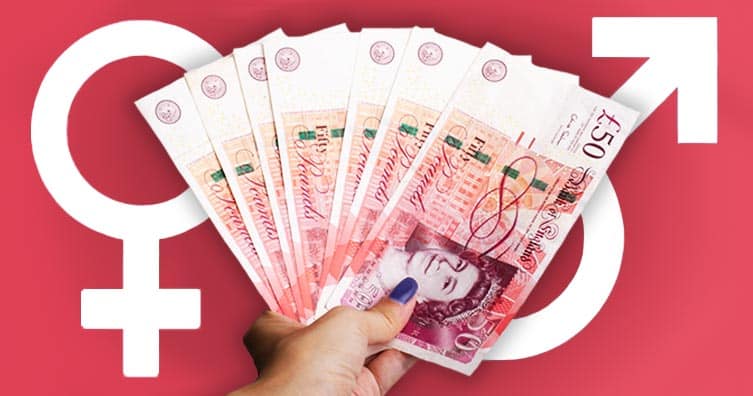Gender pay gap explained 2025
We hear about the gender pay gap a lot in the media. But, what does it mean and how does it affect you? Here's a super simple guide to get you up to speed.

Credit: SUNANTHA SRIMART, kamui29 – Shutterstock
Unfortunately, we're still a long way off from achieving true equality in the workplace. 22nd November 2023 marked Equal Pay Day – the day women effectively start working for free relative to men because of the gender pay gap. That's a whole 40 days of unpaid work.
Shockingly, women are paid on average around 14% less than men in the UK. To make sense of this (pretty huge) issue, here's your complete guide to what pay gaps mean, why they exist and what's being done about them.
What's in this guide?
What is the gender pay gap?
People often assume the gender pay gap, or 'gender wage gap', is caused by men and women getting paid different amounts of money for doing the same job. While this is part of the problem, the gender pay gap is a much more complex issue.
It's also important not to confuse it with equal pay.
The difference between the gender pay gap and equal pay
- Equal pay – As stated in the Equality Act 2010, it is illegal to pay men and women differently for performing equal work.
- The gender pay gap – This measures the difference between men's and women's average earnings across a company or the labour force as a whole.
Equal pay is a legal issue, while the gender pay gap is a much broader problem in society.
Put simply, this means that the gender pay gap is caused by much more than men and women being paid differently for the same jobs.
Many different factors contribute to the gender pay gap. This includes the different types of work that men and women do, the seniority of roles, the difference between people doing full-time and part-time work, socio-economic status, attitudes to maternity/paternity leave and much more.
Is there a gender pay gap in the UK?
Research shows that the gender pay gap in the UK is noticeable across numerous industries, but there has been a gradual improvement over recent years. The Office for National Statistics (ONS) reported:
In 2023, the gap among full-time employees increased to 7.7%, up from 7.6% in 2022. [...] Among all employees, the gender pay gap decreased to 14.3% in 2023, from 14.4% in 2022, and is still below the levels seen in 2019 (17.4%).
The official figure of 14.3% is based on the average hourly earnings of all workers, both full-time and part-time. It means that, for every £100 a man earns, a woman would generally earn £85.70.
This gap is larger still if a woman is also part of a minority ethnic group or disabled, as will be explained below.
Why does the gender pay gap exist?

Credit: MIND AND I – Shutterstock
There are many reasons why the gender pay gap exists. And it's not just about individual salaries. It's also about the kind of jobs women tend to do and their working habits in comparison with men.
Here are some of the main reasons men generally earn more than women:
-
Part-time work
According to the ONS, around 38% of women were working part-time between October 2022 and December 2022, compared to about 14% of men. For both men and women, people with part-time jobs tend to get paid less per week than their full-time colleagues.
Women choose to work part-time for a number of reasons, but one of the main ones is childcare. This leads us to our next point...
-
Childcare
Thankfully, in age groups below 40, the gender pay gap for full-time workers is now close to non-existent. But, it's still pretty significant for people aged 40+. This is most likely due to women leaving work or cutting down their hours to have children.
-
Gender inequality within industries
We all know there's no such thing as 'girl jobs' and 'boy jobs'. But, some occupations are dominated by a certain gender, and the earning potential between sectors can vary.
For example, women typically dominate roles within the teaching and care industries. The salaries for these positions are generally less than those offered to people working in management or director roles – areas that tend to be dominated by men.
While these factors clarify why the gender pay gap exists, they shouldn't be taken as excuses to explain away the issue. It's still a problem that needs addressing, but the solution clearly isn't as simple as just paying men and women the same.
To tackle this problem, we should be looking at childcare provision, attitudes to maternity/paternity leave and parenthood in the workplace, increasing accessibility in certain industries and much more.
How is the gender pay gap calculated?
As you can imagine, calculating something as complex as the gender pay gap isn't exactly straightforward, and figures vary depending on what method is used.
For example, you'll see different numbers cited depending on whether the average is calculated as a median or mean, or whether part-time jobs have been included.
The official figure is based on the average hourly pay of workers, excluding overtime hours. It is presented as a percentage difference between men's and women's earnings.
You might see variations of official figures as it's sometimes reported as the mean average, and sometimes as the median average.
But, when the mean average is used, the results could be slightly skewed if there's a small group of people in very well- or poorly-paid positions.
As the median average isn't distorted by the highest and lowest outliers, it's often considered a more accurate representation of the gender pay gap.
Median averages find the value directly in the middle of all results. When used to calculate the gender pay gap, it takes the salaries of all female employees, sorted from lowest to highest paid, and finds the central value. The difference between that employee’s salary and the median male’s salary becomes the gender pay gap.
Mean averages are calculated by adding up all results and dividing by the total number of results. So, when this method’s used to calculate the average salaries of men and women, the highest and lowest incomes of each gender can skew the results as they’re given equal weight to the most common salaries, despite being much rarer.
University gender pay gaps

Gender pay gap data share
Since 2017, all companies with over 250 employees have been legally required to record their gender pay gaps.
You can search the results on the government’s website, where you’ll find everyone from Disney to Deloitte.
In 2022/2023, 79% of reporting businesses said that medium hourly pay was higher for men than for women. Finance and insurance showed the largest gaps.
The reporting is crucial in naming and shaming the worst offenders and forcing companies to look at ways to tackle inequalities in the workplace. It should (hopefully!) empower employees at companies with a large gender pay gap to make internal changes and suggestions to drive progression.
The data needs to be updated annually. With it being so readily available to the public, it’s in the companies’ best interests to make improvements and avoid damage to their reputation.
What is the gender pay gap at your university?
All universities in the UK are now legally required to record their gender pay gaps. The results make for interesting reading.
According to the ONS, the gender pay gap for higher education teaching professionals for 2022/2023 was 7.4%.
When looking at the gender pay gaps across the entire workforce of individual unis, you can see that some have a much worse gap than this average.
Durham University has the biggest gap among Russell Group unis. Here, women earned a median hourly wage of 23.5% less than men.
On the other hand, there are a handful of universities with a gender pay gap of 0%. Noticeably, three of these are music colleges (Royal College of Music, Royal Northern College of Music and Trinity Laban Conservatoire of Music & Dance).
Fife College actually reported a pay gap of -21%, meaning that, on average, they pay women more than men. This is also the case for The College of the Holy and Undivided Trinity in the University of Oxford (-3.8%) and Cambridge Regional College (-1%).
University gender pay gaps ranked
Note: This table includes data from the 2022/23 tax year.
What are universities doing about their gender pay gaps?

Credit: Matej Kastelic – Shutterstock
Although all universities are legally required to report their gender pay gap data, commenting or explaining what they are doing to tackle it is optional.
In its 2022 Diversity Pay Report, Durham University said:
We recognise that pay diversity is a serious issue for us, as for the Higher Education Sector and society more broadly. […]
Reducing our pay gaps is an important goal for us and one that has strategic significance. A target to reduce the gender pay gap by 5% by 2025 was set in 2019, to date we have reduced the Gender Pay Gap mean by 4.3% from when statutory reporting began in 2017.
Harper Adams University, an institution that specialises in agricultural and rural disciplines, said in its March 2022 gender pay gap report:
The challenges we face in addressing the Gender Pay Gap include those relating to the
specific industry areas in which we specialise and the legacy of those areas.We are seeing changes in the balance of equality between men and women in our roles, but these are slow to come through in applications for positions that will enable significant changes to our Gender Pay Gap statistics.
We are committed to diversifying the gender characteristics of the talent pools in these areas.
Clearly, the government hopes that by making the data public, organisations will be encouraged to take steps to rectify the situation and improve their standing.
Gender pay gaps at universities compared to other sectors
When looking at the ONS 2023 gender pay gap report, it’s clear that higher education teaching professionals experience significant pay inequality. Men generally earn around 7% more than women. However, it is far from the worst industry for this issue.
For example, barristers and judges experience a gender pay gap of around 29%. And web design professionals have a pay gap of around 28%.
In contrast, for community and civil enforcement occupations, there’s a pay gap of -29%, meaning women generally earn more than men.
Ethnicity and disability pay gaps

Credit: Jacob Lund – Shutterstock
As well as the gender pay gap, there are also noticeable differences in earnings for Black and minority ethnic workers and people with disabilities.
Ethnicity pay gaps
According to a 2023 report by ONS, most ethnic minority employees earn less than UK-born White employees on average. The ethnic pay gap is particularly marked among Pakistani (16%), White and Black African (15%) and Bangladeshi (15%) people.
However, on average, White and Asian (-17.4%), Indian (-19.9%), Chinese (-23%) and White Irish (-40.1%) people earn more than those who are White British.
For most ethnic groups, men still earn more than women.
Inequality among higher education professionals
People from ethnic minority backgrounds also face serious under-representation at universities. According to 2021/22 data from HESA, among higher-education employees who do both teaching and research (i.e. professors), only around 2% are Black.
This compares to around 10% who are Asian and 78% who are White British.
Disability pay gaps
The most recent ONS report on disability pay gaps in the UK (from 2021) showed that there was a 13.8% pay gap between non-disabled and disabled employees. And, the disability pay gap was actually wider for men than women.
How you can help to close pay gaps
Pay gaps based on gender, ethnicity or disability aren’t going to disappear overnight. It’s going to take employers, educators and the government working together to create some real change.
We need better education, awareness and shifting attitudes to create real equality and fairness. But with thousands of companies legally required to reveal their gender pay gap, steps are being taken.
However, we can all do our bit to help close these pay gaps. If you, or someone you know, are being affected by an unfair pay gap at work, always report it to your manager or HR department.
Talking more openly about our salaries will also help. People often shy away from talking about pay, but this only allows pay gaps to continue. Pay gaps can only be called out and challenged if people know they exist after all.
Finally, we should all do our best to support each other in the workplace. While we need the government and employers to take real action, helping those around us where possible can help to create a more inclusive atmosphere.
Speaking up about pay gaps can take guts. You can build up your confidence by reading our guide on what to expect in your first job.








